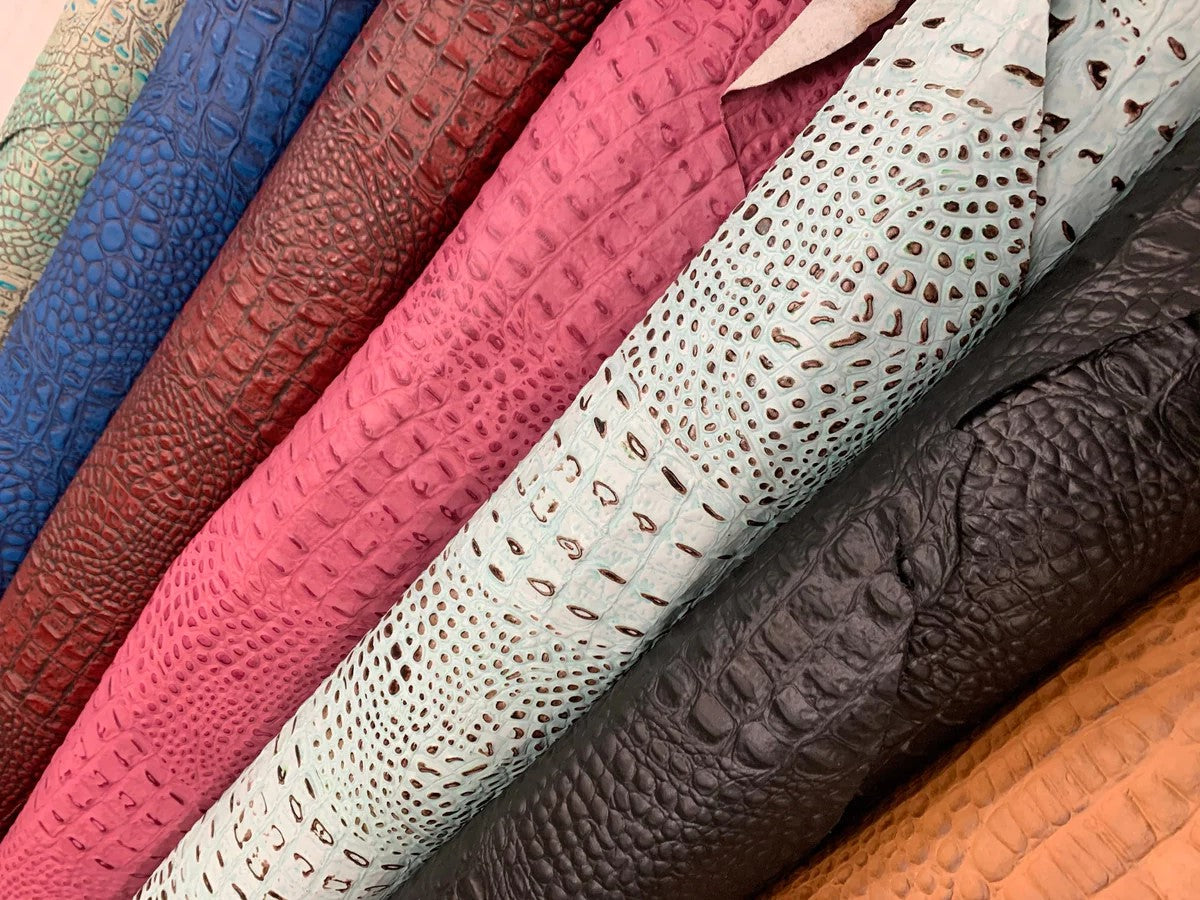
Caiman vs. Nile — Which Reigns Supreme for Your Handbag?
Crocodile skin, with its luxurious texture and supple feel, is a coveted material in the high-fashion world. Crafting to ultra-wealthy clients who demand the best, crafting a crocodile handbag is an art form requiring meticulous attention to detail. This guide unveils key tips to elevate your project and impress even the most discerning clientele.
Tip #1: Choosing Your Croc Wisely
Selecting the right crocodile species is crucial for crafting a stunning handbag. While dozens exist, two champions dominate the luxury market:
- the Caiman crocodile;
- the Nile crocodile.
Caiman boasts magnificent bony scutes, offering an undeniable aesthetic. However, this comes at a cost — reduced flexibility. Their skin proves challenging to manipulate, demanding skilled craftsmanship. In contrast, Nile crocodiles possess fewer bony deposits, resulting in greater flexibility and ease of use for handbag construction.
Consider your dyeing aspirations. Bones present a hurdle to even dye distribution. Caiman's ossified hide can make achieving vibrant, consistent color difficult. For unleashing color creativity, Nile crocodile's smoother texture becomes a valuable ally.
The perfect choice hinges on your vision. Embrace the Caiman's unique texture for a bold, natural statement, or opt for the Nile's flexibility for intricate designs and vibrant hues.
Reasons to Embrace Caiman’s Uniqueness
While Caiman skin presents a challenge compared to its smoother peers, dismissing it would be a missed opportunity. Here's why choosing Caiman for your handbag can elevate your design and showcase your expertise:
- Cost-Effective Couture. Compared to Nile or Alligator, you can afford three times the material for your project, granting you greater creative freedom and potentially higher profit margins.
- Embrace the Structured Side. Don't see rigidity as a hurdle, see it as an opportunity! Caiman's sturdy, calcium-rich scales are perfect for crafting distinctive, hard-case designs that exude strength and character.
- Authenticity with Every Scale. The uneven dye absorption due to the calcium deposits isn't a flaw, it's a badge of honor. These unique markings become a telltale sign of genuine Caiman hide, setting your product apart from imitations and highlighting its natural beauty.
- Beyond Beauty. Mastering Caiman requires exceptional craftsmanship, separating fashion aficionados from the novices. By choosing and expertly utilizing this challenging material, you demonstrate your dedication to excellence and impress discerning clientele.
Remember, Caiman isn't just a material, it's a statement. It represents your willingness to push boundaries, embrace individuality, and deliver a product that's as unique and captivating as the creature it came from.
Reasons to Work with Nile Crocodile Skin
Nile crocodile skin reigns supreme in the world of luxury handbags, and for good reason:
- Big and Beautiful. Forget patchwork! Unlike smaller hides like caiman, Nile crocodile boasts impressive 13-15 ft lengths and 70cm widths, allowing for single-skin paneling, ensuring seamless beauty and structural integrity.
- Instant Icon. No mistaking Nile's allure! Its distinctive large belly scales (14-16 per row!) create a unique aesthetic instantly recognizable as high-end exotic. Plus, the minimal bone content translates to effortless dyeing, opening doors to a vibrant color palette.
- Effortless Elegance. Compared to the rigidity of its caiman cousin, Nile boasts a dreamlike flexibility. This translates to handbags that drape gracefully, resist creasing, and maintain their pristine look longer. While some Dremel prep work is recommended, the overall ease of use is undeniable.
Nile crocodile skin isn't just a material, it's a statement of uncompromising luxury. Embrace its size, beauty, and flexibility to craft handbags that exude elegance, durability, and an instant "wow" factor. Don't miss out on this top-shelf material - elevate your designs and impress even the most discerning clientele.
Tip #2: Selecting the Perfect Size and Grade of Hides of Crocodile Skin
Crafting high-fashion handbags with crocodile skin demands meticulous attention to detail, starting with the hide itself. Your clients expect flawless craftsmanship, and that extends to the materials. Opt for top-grade (Grade I) skins, nearly free of imperfections, to ensure a luxurious final product.
Match the bag to the hide wisely. Small handbags crave 30-34cm width, medium ones require 35-39 cm, and large ones demand 40-50cm of exquisite Grade I skin.
Even Grade II hides can work magic for oversized bags, as long as flaws are relegated to the outer edges and skillfully concealed during construction.
Tip #3: Turning Scraps into Stars
Don't let leftover hide become wasted potential. Utilize it for carry straps, gussets, and interior details, creating perfect matches that seamlessly complement your bag. This saves money on extra skins and adds a touch of bespoke elegance.
If your scraps fall short, consider smaller, Grade II or III hides specifically for straps. Flaws are less noticeable on narrower pieces, allowing you to work your magic.
Ensure consistent quality by using the same cut (belly or hornback) and dye lot for straps as your main hide. This creates a cohesive look and elevates the overall craftsmanship.
Tip #4: Prepping Sewing Lines for Crocodile Couture
Working with crocodile skin, especially bonier types like Caiman or Nile, requires a bit of preparation for smooth sailing. Here's the key: prepping your sewing lines before diving in.
Calcium deposits can be your enemy, leading to bent needles and frustrated signs. Use a Dremel or similar tool to thin the hide along your planned sewing lines. This tackles those pesky calcium deposits that threaten to bend or break your needles. Don't underestimate the power of these few minutes! By pre-treating the hide, you'll save yourself hours of frustration and frequent needle replacements, keeping your sewing machine humming happily.